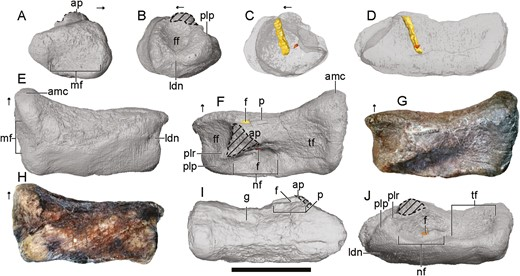MEANING: Long ago
PERIOD: Late Triassic
CONTINENT: North America
Ahvaytum is a saturnaliid sauropodomorph from the Late Triassic of what is now Wyoming. It is the oldest known dinosaur from the northern continent of Laurasia, challenging previous hypotheses of dinosaur origins and dispersal. Typical of basal dinosaurs from the Triassic, Ahvaytum was a small slender biped, reaching about 1 m in body length.

Abstract from paper: The origin of Dinosauria is thought to be deeply rooted in the high-latitude southern hemisphere (Gondwana). Nearly 6–10 million years separates Gondwanan faunas and the oldest known dinosaur occurrence in the northern hemisphere (Laurasia). However, our understanding of dinosaur origins is biased by an apparent absence of Carnian-aged (237–227 Mya) Laurasian terrestrial strata. Here we report on UWGM 1975/UWGM 7549, the oldest known Laurasian dinosaur Ahvaytum bahndooiveche gen. et sp. nov., and UWGM 7407/UWGM 7550, a silesaurid, from palaeoequatorial deposits of the lower Popo Agie Formation, Wyoming, USA. High-precision radioisotopic detrital ages [e.g. ≤229.04 ± 0.24 Mya (2σ)] from the upper Popo Agie Formation constrain an age-depth model that predicts a ~230 Mya age for UWGM 1975, making Laurasia’s first unequivocal Carnian-aged sauropodomorph dinosaur comparable in age to the oldest dinosaur faunas of Gondwana. The presence of a ~230 Mya, low-latitude, early sauropodomorph from the northern hemisphere, along with a silesaurid, challenges the hypothesis of a delayed dinosaurian dispersal out of high-latitude Gondwana. These data fill a critical gap in the early record of sauropodomorph dinosaur evolution and demonstrate widespread geographic distribution by the mid-late Carnian.
Ahvaytum is from the Triassic. The Triassic is a geologic period which spans from the end of the Permian Period 252 million years ago to the beginning of the Jurassic Period 201 million years ago. Both the start and end of the period are marked by major extinction events. The global climate during the Triassic was mostly hot and dry, with deserts spanning much of Pangea's interior. However, the climate shifted and became more humid as Pangea began to drift apart. Though it is the first period of the Mesozoic Era, the age of the dinosaurs, true dinosaurs didn't exist through most of it, finally evolving only in the Late Triassic.

Ahvaytum is a sauropodomorph. Sauropodomorpha is a group long-necked, herbivorous, saurischian dinosaurs that includes the sauropods and their ancestral relatives. Sauropods generally grew to very large sizes, had long necks and tails, were quadrupedal, and became the largest animals to ever walk the Earth. The prosauropods, which preceded the sauropods, were smaller and often able to walk on two legs. The sauropodomorphs were the dominant terrestrial herbivores throughout much of the Mesozoic Era, from their origins in the Late Triassic until their extinction at the end of the Cretaceous.
Sauropodomorphs had a light, tiny skull on the end of a long neck and a counterbalancing long tail. These adaptations gave them access to high tree foliage. The earliest known sauropodomorphs were small and slender, but by the end of the Triassic, they were the largest dinosaurs of their time, and throughout the Jurassic and Cretaceous they continued growing. They were initially bipedal, but as their size increased they evolved a four-legged gait adapted only to walking slowly on land. The early sauropodomorphs were most likely omnivores as they were only recently diverged from the carnivorous theropods.









